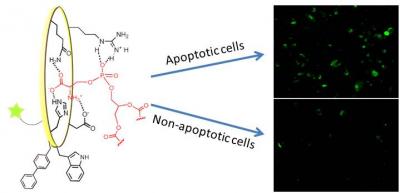Engineered molecule detects cancer cell death
September 13, 2011

The cLac molecule latches onto dying cells, while bypassing living cells (credit: Journal of the American Chemical Society)
Researchers from Boston College have developed a new class of small molecule receptors capable of detecting a lipid molecule that reveals the telltale signs of cellular death, particularly cancer cells targeted by anti-cancer drugs.
Researchers led by Assistant Professor of Chemistry Jianmin Gao successfully grafted the key residues of the milk protein lactadherin onto the molecular scaffolding of a short but sturdy circular chain of amino acids to create cyclic lactadherin (cLac) mimics capable of binding to apoptotic, or dying, cells.
Gao said his team spent a year and a half focused on a finding a new method of measuring cell death. The team wanted to create an alternative to traditional tests that measure whether or not a tumor has shrunk in size after several weeks of treatment. The team’s focus was on finding a way to measure the presence of dead cells, not the absence of tumor cells.
He’s dead, Jim
“We started by looking for a method to detect dying cells,” said Gao. “The sensitivity of scientific and medical imaging is better if you look for the appearance of something, rather than the disappearance. What we wanted to look for is that in the initial stages of treatment the therapy’s molecules are beginning to trigger the death of cancer cells. That can give you an idea a drug is working much sooner than the current methods of evaluation.”
The newly engineered cLac molecules could prove useful as a prognostic tool which could enable oncologists to determine the effectiveness of anti-cancer drugs in a matter of days rather than several weeks, said Gao, who added that further research and testing will need to be conducted.
“Given the small size and ease of synthesis and labeling, cLacs hold great promise for noninvasive imaging of cell death in living animals and, ultimately, in human patients,” Gao said.
Gao said cLac could also serve as a useful tool for researchers who use protein as a cell death indicator to screen for millions of compounds. The use of the small, peptide-binding molecule could substantially reduce costs for researchers, Gao said.
Ref.: Hong Zheng, Fang Wang, Qin Wang, and Jianmin Gao, Cofactor-free Detection of Phosphatidylserine with Cyclic Peptides Mimicking Lactadherin, Journal of the American Chemical Society, September 2011 [DOI: 10.1021/ja205911n]